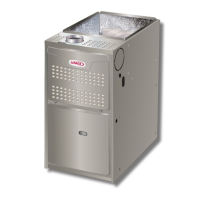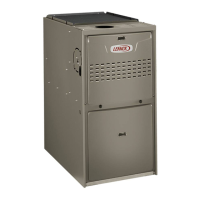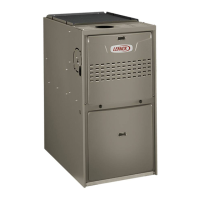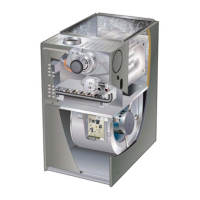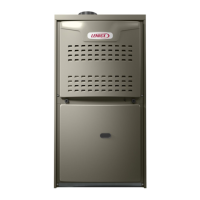Page 26
VI-MAINTENANCE
At the beginning of each heating season, and to comply
with the Lennox Limited Warranty, your system should be
checked by a licensed professional technician (or equiva-
lent) as follows:
IMPORTANT
If a higheciency lter is being installed as part
of this system to ensure better indoor air quality,
the lter must be properly sized. Higheciency
lters have a higher static pressure drop than
standardeciency glass/foam lters. If the pressure
drop is too great, system capacity and performance
may be reduced.
The pressure drop may also cause the limit to trip
more frequently during the winter and the indoor
coil to freeze in the summer, resulting in an increase
in the number of service calls.
Before using any lter with this system, check the
specications provided by the lter manufacturer
against the data given in the appropriate Lennox
Product Specications bulletin. Additional
information is provided in Service and Application
Note ACC002 (August 2000).
WARNING
Fire Hazard. Use of aluminum wire with this product
may result in a re, causing property damage,
severe injury or death. Use copper wire only with
this product.
WARNING
Failure to use properly sized wiring and circuit
breaker may result in property damage. Size wiring
and circuit breaker(s) per Product Specications
bulletin (EHB) and unit rating plate.
1 - Check wiring for loose connections, voltage at
indoor unit and amperage of indoor motor.
2 - Check the condition of the belt and shaft bearings
if applicable.
3 - Inspect all gas pipe and connections for leaks.
4 - Check the cleanliness of lters and change if
necessary (monthly).
TABLE 15
Furnace Cabinet
Width
Filter Size
Side Return Bottom Return
A - 14-1/2” 16 X 25 X 1 (1) 14 X 25 X 1 (1)
B - 17-1/2” 16 X 25 X 1 (1) 16 X 25 X 1 (1)
C - 21” 16 X 25 X 1 (1) 20 x 25 x 1 (1)
D - 24-1/2” 16 X 25 X 1 (2) 24 x 25 x 1 (1)
5 - Check the condition and cleanliness of burners and
heat exchanger and clean if necessary.
6 - Check the cleanliness of blower assembly and
clean the housing, blower wheel and blower motor
if necessary . The blower motors are prelubricated
for extended bearing life. No further lubrication is
needed.
7 - Inspect the combustion air inducer and clean if
necessary.
8 - Evaluate the heat exchanger integrity by inspecting
the heat exchanger per the AHRI heat exchanger
inspection procedure. This procedure can be
viewed at www.ahrinet.org
9 - Ensure sucient combustion air is available to the
furnace. Fresh air grilles and louvers (on the unit
and in the room where the furnace is installed)
must be properly sized, open and unobstructed to
provide combustion air.
10 - Inspect the furnace venting system to make sure
it is in place, structurally sound, and without holes,
corrosion, or blockage. Vent system must be free
and clear of obstructions and must slope upward
away from the furnace . Vent system should be
installed per the National Fuel Gas Code.
11 - Inspect the furnace return air duct connection to
ensure the duct is sealed to the furnace. Check for
air leaks on supply and return ducts and seal where
necessary.
12 - Check the condition of the furnace cabinet insulation
and repair if necessary.
13 - Perform a complete combustion analysis during the
furnace inspection to ensure proper combustion
and operation. Consult Service Literature for proper
combustion values.
14 - Verify operation of CO detectors and replace
batteries as required.
Perform a general system test. Turn on the furnace to
check operating functions such as the start-up and shut-of
operation.
1 - Check the operation of the ignition system, inspect
and clean ame sensor. Check microamps before
and after. Check controls and safety devices (gas
valve, ame sensor, temperature limits). Consult
Service Manual for proper operating range. Thermal
Limits should be checked by restricting airow and
not disconnecting the indoor blower. For additional
details, please see Service and Application Note
H049.
2 - Verify that system total static pressure and airow
settings are within specic operating parameters.

